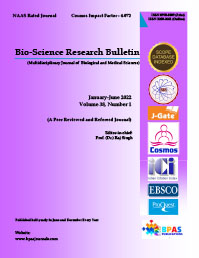Folk Physician Applications in Everyday Life in Turkey
DOI:
https://doi.org/10.48165/Keywords:
Folk Remedies, Folk Medicine, Healing, Aromatherapy, Functional Foods, Tıbb-ı NebewiAbstract
In this study, it can be easily applied for human in the various region of Turkey about 80 cures/medication are explained. A total of approximately 80 applications are described, including 5 for infant and child health, 10 for preventive medicine, 4 for pests. Numerous applications like bad breath, dental health, internal organ diseases, physiological and infectious diseases, hair loss or removal, burns, various health problems caused by nutritional deficiencies, accidental injuries, food and animal poisonings, ways of protection from poisonous animals etc. are described in the paper. View to diseases and patiens of folk physicians are very different. They give priority to environment and public health with an ecological approach. We have been made the findings based on observations since 1983, from especially in Eastern Anatolia and Mediterranean regions. Most of materials used in folk medicine are from plant origin. Aromatherapy and essential oils, functional foods have an important place in folk medicine. It is indispensable for rural people as a necessity of daily life. Folk medicine which started with a search for a solitions to the health problems of pets, started to be applied to humans in time. Scientific infrastructure of it has been formed with the experiences of centuries. Most important source of inspiration is Prophet Medicine (Tıbb-ı Nebewi). It develops with the method of nomadism, animal husbandary and trial and error.
References
Altıntaş, A. (2017). Osmanlı hekimlerinin sağlık kuralları. Milenyum Yayınları.
Altıntaş, A. (2018). Osmanlı tıbbında sağlıklı yaşam. Yediveren Yayınları. 3. Davis, P.H. (1965-1985). Flora of
Turkey and the Aegean islands (I-IX). Edinburgh University Press.
Duran, A. (1998). Local names and ethnobotanical features of some plants in Akseki (Antalya). The Herb Journal of Systematic Botany, 5(1), 77-
John, S., & Sharma, P.C. (2020). Nutritional approach for the treatment of anemia and iron deficiency Anemia. Bio-Science Research Bulletin, 36(1), 50-54.
Gurhan, G., & Ezer, N. (2004). Plants used in the treatment of hemorrhoids 1. Journal of Hacettepe University Faculty of Pharmacy, 24(1), 37-55.
Ivanov, I.I., Lancev, I.I. & Neşev, G.K. (2005). Şifalı bitkilerle tedavi atlası (B. Makaklı, Çev.). Pamuk Yayınları.
Erdem, S. (2020). İslam Ansiklopedisi. https://islamansiklopedisi.org.tr/buh ur.
Kadıoğlu, S., Kadıoğlu, B., & Karagöz Sezer, K. (2021). Ethnobotanical properties of natural plants in Kop Mountain Pass (Bayburt /Turkey). Biological Diversity and Conservation, 14(2), 264-276.
Karabulut, A.R. (1994). Tıbbı Nebevi Ansiklopedisi (4. Baskı). Mektebe Yayınları. Korkmaz, M., & Karakurt, E. (2015). An ethnobotanical ınvestigation to determine plants used as folk medicine in Kelkit (Gümüşhane/Turkey) district.
Biological Diversity and Conservation, 8(3), 290-303.
Korkmaz M., Karakus S., Selvi S., & Cakilcioglu, U. (2016). Traditional knowledge on wild plants in Uzumlu (Erzincan-Turkey). Indıan Journal of Traditional Knowledge, 15(4), 538-
Özçelik, H. (1987). The names and methods of using some plants which are growing naturally in and around Akseki. Turkish Journal of Botany, 11(3), 316-321.
Özçelik, H. (2019). Biodiversity in the Lakes region (Turkey) and its agricultural importance. Süleyman Demirel University Journal of Natural and Applied Sciences, 23(2), 315-328.
Özçelik, H. (2021). Tarhana soup in Turkey: preparation and service. Modern Concepts & Developments in Agronomy, 9(4), 945-950.
Özçelik, H. (Ed.). (2016). Burdur ilinin bitki envanteri (Ekonomik, nadir ve endemik bitkileri). Burdur Belediyesi Kültür Yayınları.
Özçelik, H., & Moran, İ. (2020, June). Folk drugs and folk medicine applications in daily life in Turkey. In M. Polat (Ed.), 3rd International Health Science and Life Congress, Burdur, (pp.180-203).
Öztürk, M., & Özçelik, H. (1991). Doğu Anadolu'nun faydalı bitkileri (Useful plants of east anatolia). SİSKAV Yayınları.
Özçelik, H., & Kündük, Ş. (2021). Preliminary trials on medical gum production. Süleyman Demirel University Journal of Natural and Applied Sciences, 25(2), 185-194.
Özçelik, H. (1989). Van ve yöresinde süt mamüllerinin hazırlanmasında yararlanılan bitkilerin kullanılışları üzerine bir araştırma. TÜBİTAK, DOĞA
Türk Tarım ve Ormancılık Dergisi, 13(2), 356-360.
Özçelik, H. (1994). Notes on the economic plants (on the herbal cheese from East Anatolia-Turkey). Economic Botany, 48(2), 214-217.
Özçelik, H. (2018, November). Some plants from the creation miracle and their presentation. In N.Yatkın, Ö.İ. Kührevioğlu, O. Erdoğan, A. Dursun, & H. Ceylan (Eds.), 2’th International Creation Congress in the Light of Sciences, Erzurum, (pp. 107-130). Atatürk University.
Özgökçe, F., & Özçelik, H. (2005). Ethnobotanical aspects of some taxa in East Anatolia (Turkey). Economic Botany, 58(4), 697-704.
Polat, R., Satil, F., & Cakilcioğlu, U. (2011). Medicinal plants and their use properties of sold in herbal market in Bingöl (Türkiye) district. Biological Diversity and Conservation,4(3), 25-35.
Sezik, E.(2015, Ağustos). Türkiye’de halk ilacı araştırmaları- Genel değerlendirme, In H. Özçelik, & M. Karataş (Eds.), II. Ulusal Botanik Kongresi (Türkiye), Afyonkarahisar (p 2).
Singh, R., Yadav, M., Kumar, V., Sharma, I., Singh, M., & Upadhyay, S.K. (2021). Effect of molasses on the growth of Okra, Abelmoschus esculentus (L.) Moench (Dicotyledonae: Malvaceae). Bio-Science Research Bulletin, 37(1), 4-11.
Türkiye. The Ministry of Culture and Tourism. (2021). Sultan II. Bayezıd Complex Health Museum https://edirne.ktb.gov.tr/TR
/sultan-ii-bayezid-kulliyesi saglik-muzesi.html
